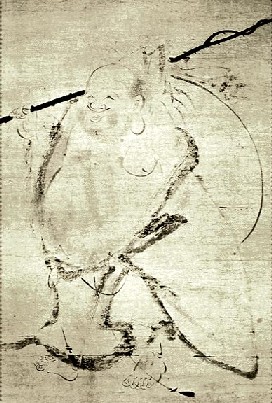|
|
|
Zen painting ~1200-1600

|
Hotei, by Mokuan
|
Zen painting seems to start in the early 13th century with images of revered priests.
It develops into a distinct style within Japanese painting quite quickly - perhaps this
is partly because it generally came with some sort of message, mostly a san or aphorism,
explicitly stated in writing on the image; a development from this was the
Shigajiku in the late 14th century. Zen painting then thrived
to a huge degree thanks to its landscape painting, especially by the towering figure of
Sesshu. This was a period when Zen monks could be primarily professional artists, with
only residual religious connections. The work was, it is always claimed, expressing the
Zen mind, but given how vague that idea is, we pretty quickly find ourselves in a circle where
no one says anything useful. What we actually see on the paper or silk is art of
immensely skilled technique, from highly trained artists with a thorough knowledge and
consciousness of at least some strands of art history, its practices and methods. This
stultifies some, provides an interesting framework for others, and sometimes its something
to rebel against, but there is an obvious awareness of being a professional painter in a history
of painters, of fitting in in some way. This was to change...
|
|

